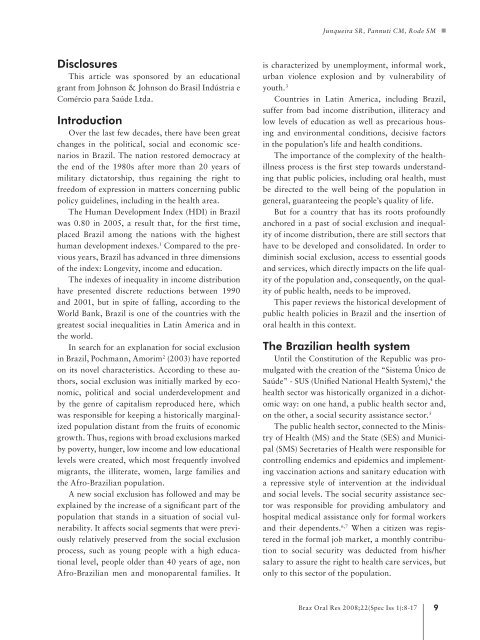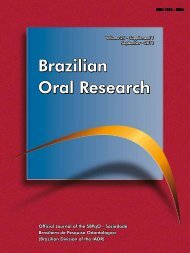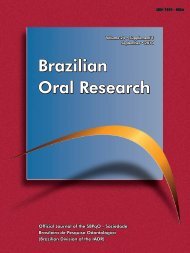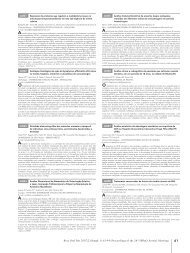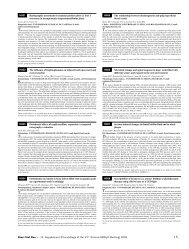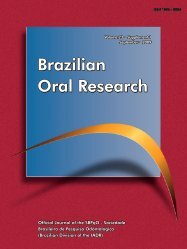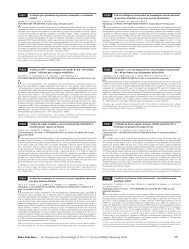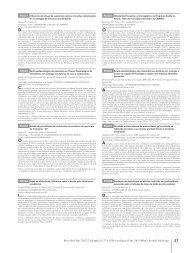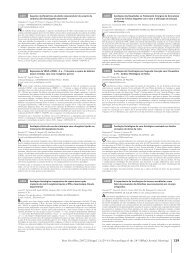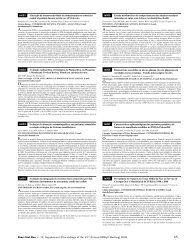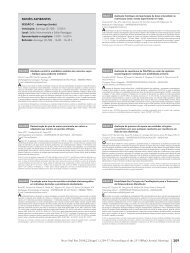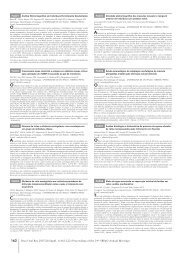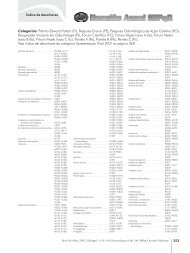Brazilian Oral Research Brazilian Oral Research Brazilian Oral
Brazilian Oral Research Brazilian Oral Research Brazilian Oral
Brazilian Oral Research Brazilian Oral Research Brazilian Oral
You also want an ePaper? Increase the reach of your titles
YUMPU automatically turns print PDFs into web optimized ePapers that Google loves.
Disclosures<br />
This article was sponsored by an educational<br />
grant from Johnson & Johnson do Brasil Indústria e<br />
Comércio para Saúde Ltda.<br />
Introduction<br />
Over the last few decades, there have been great<br />
changes in the political, social and economic scenarios<br />
in Brazil. The nation restored democracy at<br />
the end of the 1980s after more than 20 years of<br />
military dictatorship, thus regaining the right to<br />
freedom of expression in matters concerning public<br />
policy guidelines, including in the health area.<br />
The Human Development Index (HDI) in Brazil<br />
was 0.80 in 2005, a result that, for the first time,<br />
placed Brazil among the nations with the highest<br />
human development indexes. 1 Compared to the previous<br />
years, Brazil has advanced in three dimensions<br />
of the index: Longevity, income and education.<br />
The indexes of inequality in income distribution<br />
have presented discrete reductions between 1990<br />
and 2001, but in spite of falling, according to the<br />
World Bank, Brazil is one of the countries with the<br />
greatest social inequalities in Latin America and in<br />
the world.<br />
In search for an explanation for social exclusion<br />
in Brazil, Pochmann, Amorim 2 (2003) have reported<br />
on its novel characteristics. According to these authors,<br />
social exclusion was initially marked by economic,<br />
political and social underdevelopment and<br />
by the genre of capitalism reproduced here, which<br />
was responsible for keeping a historically marginalized<br />
population distant from the fruits of economic<br />
growth. Thus, regions with broad exclusions marked<br />
by poverty, hunger, low income and low educational<br />
levels were created, which most frequently involved<br />
migrants, the illiterate, women, large families and<br />
the Afro-<strong>Brazilian</strong> population.<br />
A new social exclusion has followed and may be<br />
explained by the increase of a significant part of the<br />
population that stands in a situation of social vulnerability.<br />
It affects social segments that were previously<br />
relatively preserved from the social exclusion<br />
process, such as young people with a high educational<br />
level, people older than 40 years of age, non<br />
Afro-<strong>Brazilian</strong> men and monoparental families. It<br />
Junqueira SR, Pannuti CM, Rode SM<br />
is characterized by unemployment, informal work,<br />
urban violence explosion and by vulnerability of<br />
youth. 3<br />
Countries in Latin America, including Brazil,<br />
suffer from bad income distribution, illiteracy and<br />
low levels of education as well as precarious housing<br />
and environmental conditions, decisive factors<br />
in the population’s life and health conditions.<br />
The importance of the complexity of the healthillness<br />
process is the first step towards understanding<br />
that public policies, including oral health, must<br />
be directed to the well being of the population in<br />
general, guaranteeing the people’s quality of life.<br />
But for a country that has its roots profoundly<br />
anchored in a past of social exclusion and inequality<br />
of income distribution, there are still sectors that<br />
have to be developed and consolidated. In order to<br />
diminish social exclusion, access to essential goods<br />
and services, which directly impacts on the life quality<br />
of the population and, consequently, on the quality<br />
of public health, needs to be improved.<br />
This paper reviews the historical development of<br />
public health policies in Brazil and the insertion of<br />
oral health in this context.<br />
The <strong>Brazilian</strong> health system<br />
Until the Constitution of the Republic was promulgated<br />
with the creation of the “Sistema Único de<br />
Saúde” - SUS (Unified National Health System), 4 the<br />
health sector was historically organized in a dichotomic<br />
way: on one hand, a public health sector and,<br />
on the other, a social security assistance sector. 5<br />
The public health sector, connected to the Ministry<br />
of Health (MS) and the State (SES) and Municipal<br />
(SMS) Secretaries of Health were responsible for<br />
controlling endemics and epidemics and implementing<br />
vaccination actions and sanitary education with<br />
a repressive style of intervention at the individual<br />
and social levels. The social security assistance sector<br />
was responsible for providing ambulatory and<br />
hospital medical assistance only for formal workers<br />
and their dependents. 6,7 When a citizen was registered<br />
in the formal job market, a monthly contribution<br />
to social security was deducted from his/her<br />
salary to assure the right to health care services, but<br />
only to this sector of the population.<br />
Braz <strong>Oral</strong> Res 2008;22(Spec Iss 1):8-17


